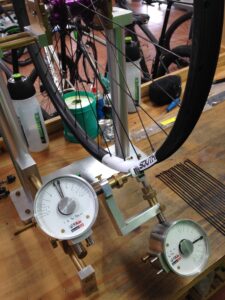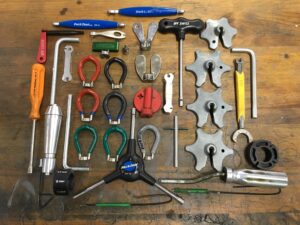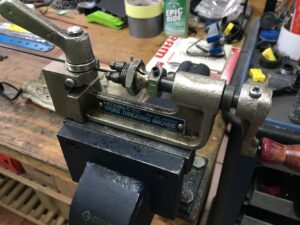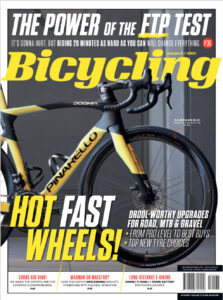All You Need To Know To Buy Your Next Wheels [Or Tyres]
If Covid has crushed your new-bike budget, a new set of wheels is almost as good!
As bikes become harder to find, due to pandemic-hampered production around the world (not to mention finding the money for them!), what’s the simplest and most cost-effective way to upgrade your ride? Wheels and tyres, of course. We’ve got expert advice and a bumper buyer’s guide to keep you rolling.
This article appears in the September issue of Bicycling – on sale now or hit Magzter for your digital copy. (There is much more to it, including a lekker guide to what wheels you should buy, and the tyres that match them perfectly).
Expertise in the art of wheel-building is earned; not by watching YouTube videos, but by years of repetition, years of experimentation, successes and failures, long nights spent at a truing stand. And perhaps, just a little magic in the fingertips.
Someone who knows the truth of this is master wheel-builder William Keith (56), the owner of William’s Bike Shop in Somerset West. Over the past three decades, William has seen mountain bike wheels grow from 26” to 27.5” to 29”, experienced the evolution of carbon as a rim material, and watched as tubeless tech has finally infiltrated the road market.
We asked him everything we’ve ever wanted to know about wheels – and some of his answers were a little surprising…
Why upgrade your wheels?
“The majority of bikes are specced to sell at a certain price point, and the manufacturers’ favourite trick is to kit bikes out with good-looking wheels that are actually a few notches down the scale when compared to the groupset,” William says. “These are never bad wheels – it’s actually very difficult to buy truly rubbish wheels, these days – but they are heavy, and they do the rest of the bike an injustice.”
Is wider better?
The second reason to upgrade is the swing towards wider rims and fatter tyres, which combine to give you a more comfortable and faster ride experience.
On the road, the sweet spot has shifted from 23c tyres for racing to 28c, run at pressures as low as 75psi in the pro peloton. It sounds wrong, but more rubber on the road – gripping it at lower pressure – actually rolls faster and more efficiently, as it absorbs the micro-bumps that stop and start over-inflated, skinny tyres. At an imperceptible level, but it’s still measurable.
On the gravel and mountain-bike side, XC racing snakes often run 2.3-2.4” tyres, at insanely low pressure, now that they’ve worked out the benefits of floating instead of bouncing.
New wheels and tyres will make your old bike feel like a million bucks! On the road, aim for wider, semi-aero rims, wider tyres and quality hubs. Off-road, go for a wide rim with a hookless bead, and fit as wide a tyre as your frame will sensibly accept.
The reward will be speed and comfort, in spades.
With wider tyres, you need wider rims. “I truly believe in matching rim width to preferred tyre width for the discipline of riding you do,” says William. “Wide tyres on narrow rims roll and corner horribly, and narrow tyres on wide rims result in a very high risk of the sidewall being your contact with road or trail surface when cornering – it’s a trip to the ER waiting to happen.”
Also, hookless for tubeless is the way forward. Does that mean your three-year-old hooked rims are suddenly bad? “No, not at all,” says William. “But when you do need to replace that rim, go for the hookless version.”
‘Hookless’ refers to the internal profile of the rim: conventional rims have a ‘hook’ profile to keep the tyre in place, whereas the latest rims use a straight profile for a tighter, more streamlined bead fit.
Tubeless on the road?
“I still ride tubes on the road, and I love them,” says William. “I’ve tried tubeless on the road – there are advantages, such as ride quality, traction, and less rolling resistance – but many of my clients complain about the mess the sealant makes on the bike when the tyre punctures. And even worse, the mess on your kit!
“Another common complaint is when the sealant doesn’t do its job, and a tube has to be fitted. Either the tyre is so tight that the rider can’t remove it from the rim, or once the tube is fitted, the tyre won’t seat properly.
“My feeling is that the technology still has a way to go before being universally acceptable to the average road cyclist. It will get there, though, because the market demands it.”
Is custom king?
Yes. And no. If you already have nice wheels, you might be able to use the hubs and get a wheel builder to modernise them with new rims and spokes. Or you could go the whole hog, and get wheels built from scratch.
The only real disadvantage of custom hoops is the cost: Expert labour is a premium product, and it’s vital in something as finicky as wheel-building.
But even if you have the budget, you shouldn’t discount pre-built wheels either. “Factory wheels are good,” says William. “Some are even excellent; but expect to drop some serious zeros for factory-built excellence.
“There’s a reason a R3k wheelset only costs R3k. Perhaps the spoke tension is all over the show, maybe cheap bearings have been used, or low-grade alloy for the rim. A cheap freehub has a slow take-up speed, and a less robust engagement ring…

“That said, there are many superb mid-priced factory wheelsets out there. Even as a wheel builder, I would recommend a R9k toR17k factory-built road wheel set for the average cyclist over a custom-built set at a similar price.
“Mountain biking is a different story – there are so many variables, including suspension, rider weight, the type of riding someone wants to do… That’s when custom expertise really comes into play.”
I’ve bought my wheels – now what?
“Factory wheels invariably need some kind of tuning by the bike shop before being allowed out of the door,” says William. “In the case of cup-and-cone hubs, the cone tension is often horrifically high; which makes them slow, and kills the bearing surfaces.
“The biggie, though, is spoke tension: many top-end wheels come over-tensioned, making for a harsh ride, and cracked rims further down the road. Mid- and entry-level wheels tend to be unevenly or under-tensioned. Not all of them – the big-name brands are getting much better, and the boutique wheels tend to be hand-built anyway – but a good bike shop sorts this out before they’re ridden.”
What makes a strong wheel?
“A wheel is only as strong as its weakest component,” William warns. “If a wheel is built with low-grade spokes, those spokes will break. If the rim design is poor, or the grade of alloy or carbon is inferior, then the likelihood of failure is high. Don’t expect a hub intended for a commuter bike to survive in a trail-bike wheel.”

Then there’s the quality of craftsmanship. “People who have never held a spoke key always say that spoke tension must be 100% equal across each face,” William says with a laugh. “Yes, spoke tension is important, and a wheel-builder should strive to achieve as small a variance in tension as possible; but an experienced builder knows where this variance works and where it doesn’t. The art is finding the balance between spoke tension consistency and wheel trueness to produce a strong, balanced and correctly dished wheel.”
Are carbon wheels worth it?
Your budget should decide this. If it means taking food off the family table, they’re definitely <itals>not worth it! But if you want real improvement in handling and ride quality, then yes – carbon is worth every cent.
On the subject of inexpensive, often unbranded carbon rims from anonymous Chinese factories, the reality is that you get what you pay for. “Carbon rims are strong, but that doesn’t mean they can’t fail,” says William. “I’ve seen high-quality rims crack, but the rider rode home without the tyre deflating. It’s a fail, but it’s not catastrophic. I’ve also seen some failures of no-name carbon rims resulting in some nasty loss of skin and worse.
“The flip side, of course, is that there are plenty of stories of cyclists riding inexpensive carbon rims hassle-free for several years.”
Carbon is great, but it’s not the be-all and end-all. “There are plenty of alloy rims available that have fantastic price-to-performance ratio,” William says. “Do your homework, and you’ll end up with excellent wheels that don’t cost the earth.”
What about spoking patterns?
William recommends that the majority of mountain bikers stick to 32-hole three-cross, or 28-hole two-cross:
“They’re good, uncomplicated patterns, and they work,” he says. “If your wheel uses straight-pull spokes, make sure the wheel builder provides you with a few spares of the correct length – not all bike shops carry straight-pull spokes.
“For road bikes with rim brakes, I have to admit that I love a 20-spoke radial front wheel, matched to a 24-spoke radial/two-cross for the rear; but this is not the ideal set-up for everyone. Road and gravel bikes with discs should not have radial lacing – a 24-spoke two-cross or a 28-spoke will produce a much better ride, especially for a heavier rider.

“Some factory-built road wheels have wonderfully creative lacing patterns: two-for-one, twinning of spokes, groupings of three or even four spokes… Ask your bike shop whether that wheel is easy to repair; because some of those wheels are right bastards, and beyond the abilities of your average mechanic. Be prepared for a delay while the wheel is sent – at your cost – to the distributor, who hopefully has the specialised tools and the skill set to repair your wheel.”
Is the rider weight limit important?
“Absolutely. There’s a reason we don’t put a 95kg guy on a 140mm trail bike on a Stan’s Crest rim!” William says. “Some of the manufacturer weight limits might be on the cautious side, but this is understandable. My advice is to take heed of the rider weight limit.”
How should I care for my wheels?
“Wheel care is imperative,” William says. “If you have cup-and-cone hubs, check for hub play regularly. The moment you pick it up, send the wheels into your LBS for a tune-up – but please, do the honourable thing and clean them first! Owners of such wheels, remember that ball bearings and cones can be replaced; but if you’ve ridden too far on a loose hub and the cup is worn, that hub will never be smooth again…
“At the other end of the scale, with something like a Chris King hub, just because it’s the Rolls Royce of hubs that doesn’t mean you can ignore the service requirements. It still needs to be serviced! Good housekeeping dictates at least an annual hub service, regardless of brand. If you’ve taken part in a particularly wet and muddy race – or even a dry and dusty one – I’d recommend having your wheels inspected and serviced.”
Does light weight equal fast?
More rands will buy you fewer grams, but even inexpensive wheelsets are pretty light these days: so you can pay R50k for a 1 400g wheelset, or R5k for a 1 900g one. Do the maths…
Lighter is obviously better; but according to William, aero is what makes you faster. Unless you’re facing Alpine climbs, there are plenty of aero gains to be made.
Does this mean we should all be riding 80mm deep-sections? “No – that’s for the pros who sit at 40km/h and more all day,” says William. “But a modern 40-50mm rim with the appropriate-width tyre will be your fastest option, even on the climbs.
“Medium-depth rims are also manageable in mild to medium wind; although I wouldn’t fit more than a 40mm on the front at the coast, or any other frequently windy environment. It’s just too difficult to keep them going where you want them to go.”
Twenty-nine by what?!
Wheel sizes and tyre widths can be confusing.
In mountain biking, the go-to nomenclature is inches, denoted by the double-quote mark: the most common wheel is 29”, which refers to the overall size of wheel and tyre together. A 29er rim by itself is actually only 24.5” in diameter, or 622mm. (Slightly smaller 27.5” wheels were also common a few years ago, but this size has largely moved to niche areas of the sport such as downhill and enduro.)
The width of mountain-bike tyres is also measured in inches; so for example, a 29×2.35” tyre will have a 29” diameter and be 2.35” wide when inflated. But this is not always accurate, as rim width can affect tyre width.
Road wheels and tyres generally use different nomenclature. If you look at a road-specific tyre, it might say ‘700x28c’ on the sidewall; the ‘700’ refers to the rim diameter. Which is actually 622mm. Explaining the origins of this discrepancy would take way too many pages, but the important thing to note is that a 700 road wheel has the exact same rim diameter as a 29” mountain-bike wheel.
The ‘28’ part refers to the width of the road tyre in millimetres, and the ‘c’ is part of an old French system that classified tyre width using codes, from ‘a’ (the narrowest) to ‘d’ (the widest). You’re unlikely to see anything but ‘c’ these days.
In short, you can use road tyres on a mountain-bike rim, and vice versa; as long as you’re swapping between 700 road and 29” MTB, the tyre and rim widths are compatible, and the whole lot will clear your forks and your frame. Off you go!
In summary?
New wheels and tyres will make your old bike feel like a million bucks! On the road, aim for wider, semi-aero rims, wider tyres and quality hubs. Off-road, go for a wide rim with a hookless bead, and fit as wide a tyre as your frame will sensibly accept.
The reward will be speed and comfort, in spades.
CHECK OUT OUR WHEELS BUYERS’ GUIDE IN THE SEPTEMBER ISSUE

READ MORE ON: equipment tech tyres wheel-building wheels



